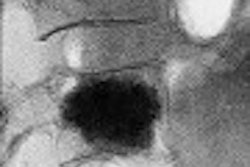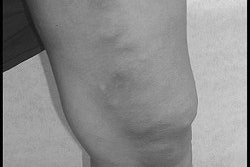The user would be hard pressed to find a disease not covered on this CD, with an emphasis on the most common ones.
ACR Learning File CD-ROM Series: Vascular & Interventional by Kevin W. Dickey, Peter N. Waybill, and Nilesh H. Patel
American College of Radiology, Philadelphia, 2003
$199 for ACR members; $500 for non-members; $99 for members-in-training
The ACR has once again proven itself as the primary source for radiology teaching files. This Vascular & Interventional CD offers an impressive depth and breadth of coverage, creating a new standard for interventional radiology teaching files.
This CD features a revamped interactive format, moving closer to simplicity and ease-of-use with an eye towards elegance. The categories are tab listed in a vertical box, rather than horizontally, creating less eye-strain and encouraging rapid familiarity with topic locations. This product offers the same intuitive navigation, excellent images, discussions, self-testing quizzes, and search capabilities found in the other ACR CDs. A new category on treatment has been added.
The user would be hard pressed to find a disease not covered on this CD, with an emphasis on the most common ones. Peripheral vascular disease, acute and chronic, is explored in detail. Arterial and venous pathology, and their pathologic connections, is reviewed thoroughly. Hepatobiliary diseases are discussed, with over 30 cases devoted to neoplasms, trauma, and most areas in between.
Genitourinary, reproductive pathology, and abscess/fluid collections make up the remainder of the sections, covering the basics (percutaneous nephrostomy) and advanced concepts (methamphetamine abuse necrotizing angiitis). The cases are tailored to meet the needs of all interventionalists, whether they are already practicing or preparing for the oral boards. Most cases include pre-treatment imaging (plain-film, US, CT, MRI, digital subtraction angiography), with corresponding post-treatment comparisons.
The weaknesses of this software most likely stem from its collaborative nature. The cases are collected from physicians nationwide and, although a standard for submission is requested, it seems to be followed to varying degrees.
The CD also falls short on discussion and reviews. At 451 MB, there is ample room for more thorough discourse on every subject, as well as more details on treatment protocols, as this information is fundamental to interventions. Every resident who has been involved in an IR case knows that he or she will ultimately be asked: "So what would you do next?"
This latest ACR teaching file does offer a near-comprehensive review of the pathology common to interventional radiology, making it the best of the education tools in this field.
By Dr. Daniel ReidmanAuntMinnie.com contributing writer
November 18, 2003
Dr. Reidman is a radiology resident at the Madigan Army Medical Center in Tacoma, WA.
The opinions or assertions contained herein are the private views of the author and are not to be construed as official or as reflecting the views of the Department of Defense.
The opinions expressed in this review are those of the author, and do not necessarily reflect the views of AuntMinnie.com.
Copyright © 2003 AuntMinnie.com



















